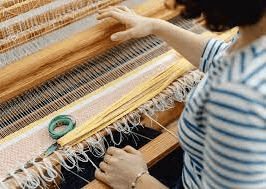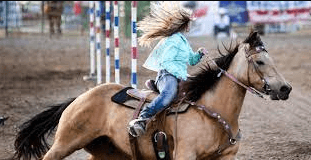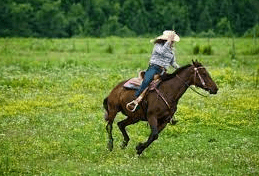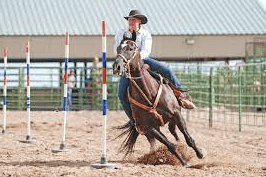Can You Explain The Proper Techniques For Weaving Through The Poles Effectively?

Have you ever felt the exhilaration of effortlessly gliding through a series of poles, weaving in and out with precision and grace? Pole weaving, also known as slalom skiing or agility training, is a captivating sport that requires both skill and technique.
In this article, we will delve into the proper techniques for effectively maneuvering through the poles, providing you with valuable insights to help you master this thrilling art form.
Imagine yourself on a pair of skis or rollerblades, moving with fluidity and freedom. The poles stand tall before you like gatekeepers to a realm of excitement and liberation. To navigate through them successfully, it is essential to understand the basics of pole weaving.
This includes mastering body positioning and timing, achieving balance and stability, as well as developing agility and precision. These fundamental elements lay the foundation for your journey towards becoming an adept pole weaver.
As we embark on this exploration together, remember that pole weaving is not only about conquering physical obstacles but also about finding inner freedom. The act of gracefully maneuvering through each pole mirrors our subconscious desire to break free from constraints and limitations.
So let us delve into the world of pole weaving – where technique meets liberation – as we uncover invaluable insights that will empower you on your journey towards becoming an expert in navigating through these mesmerizing structures.
Understanding the Basics of Pole Weaving
The proper techniques for effectively weaving through poles can be understood by gaining a foundational knowledge of the basics of pole weaving.
Mastering pole control is essential in this skill, as it allows the weaver to navigate through the poles with precision and ease. By having a firm grip on the pole and maintaining a balanced posture, the weaver can maneuver through tight spaces without getting entangled or knocking down any poles.
Additionally, improving pole weaving speed requires practice and focus. It is crucial to develop quick reflexes and sharp eye coordination to anticipate upcoming obstacles and make split-second decisions on which path to take.
By honing these skills, weavers can enhance their efficiency in navigating through poles, ultimately achieving faster weaving times.
Mastering Body Positioning and Timing
Optimal performance while maneuvering through poles requires precise body positioning and impeccable timing. To improve coordination and optimize body movements, it is crucial to understand the importance of maintaining a balanced stance when weaving through the poles.
This involves keeping the weight evenly distributed between both feet, with a slight forward lean from the ankles. By doing so, the rider can effectively shift their weight in response to each pole, allowing for quick and seamless transitions.
Additionally, timing plays a critical role in successfully navigating through the poles. It is essential to anticipate each pole’s position and adjust body positioning accordingly to ensure smooth passage. By practicing this skill repeatedly, riders can develop muscle memory and enhance their ability to instinctively react to changes in pole placement.
Mastering body positioning and timing not only enhances overall performance but also provides riders with a sense of freedom as they effortlessly weave through the poles with precision and grace.
Achieving Balance and Stability
Achieving balance and stability is key when maneuvering through a course of poles, as it allows riders to seamlessly navigate their way with precision and grace.
Improving coordination plays a crucial role in maintaining control while weaving through the poles. Riders must have a strong sense of body awareness and be able to synchronize their movements with the horse’s rhythm. This requires practice and focus on developing core strength, flexibility, and proprioception.
By engaging the core muscles and maintaining an upright posture, riders can create a stable base that enables them to make quick adjustments in their position without compromising their balance. Additionally, riders should distribute their weight evenly in the saddle, keeping their heels down and maintaining a light contact with the horse’s mouth. This helps establish clear communication between horse and rider, allowing for smooth transitions between poles.
Furthermore, riders should anticipate the movements of the horse by looking ahead and planning their path in advance. By doing so, they can make timely adjustments to maintain balance throughout each turn or change of direction.
Achieving balance and stability not only enhances safety but also contributes to the overall aesthetic appeal of pole weaving as it showcases the harmonious partnership between horse and rider.
The Importance of Proper Weight Distribution
Proper weight distribution is a crucial aspect to consider when navigating through a course of poles, as it directly impacts the rider’s ability to maintain balance and control.
Achieving the correct weight distribution involves utilizing proper footwork and maintaining momentum.
When weaving through the poles, it is essential for riders to distribute their weight evenly between both legs, allowing for stability and agility.
By keeping their center of gravity low and centered over the horse, riders can effectively maneuver through the poles with ease.
Additionally, maintaining momentum is key in successfully navigating through the course.
Riders must ensure that they maintain a consistent pace throughout, as sudden changes in speed or direction can disrupt their balance and hinder their progress.
Proper weight distribution, combined with precise footwork and controlled momentum, allows riders to maximize their performance while weaving through poles effectively.
Developing Agility and Precision
To enhance equestrian performance, it is imperative to develop a high level of agility and precision while maneuvering through the course of poles.
Improving coordination and increasing reflexes are key factors in achieving this level of skill.
Here are some techniques that can help riders develop agility and precision:
- Visual Focus: Riders should focus their gaze on the next pole or obstacle, allowing them to anticipate their horse’s movements and make timely adjustments.
- Body Positioning: Maintaining a balanced and centered position allows riders to respond quickly to changes in direction or speed.
- Timing and Rhythm: Coordinating the horse’s stride with each pole is crucial for maintaining a smooth flow through the course.
- Practice Drills: Regularly practicing weaving exercises can help riders improve their ability to navigate between poles efficiently.
By incorporating these techniques into their training regimen, equestrians can enhance their ability to weave through poles effectively, achieving a higher level of agility and precision in their riding.
Practicing Essential Techniques for Maneuvering through Poles
Developing a high level of agility and precision while maneuvering through the course of poles requires riders to practice essential techniques such as maintaining visual focus, proper body positioning, coordinating timing and rhythm, and engaging in regular weaving exercises.
Effective pole weaving drills can help riders improve their technique by providing opportunities to practice navigating through a series of poles with speed and accuracy. These drills often involve setting up a course of poles in various patterns, such as straight lines or zig-zags, and challenging the rider to weave through them without knocking any over.
By repeatedly practicing these drills, riders can enhance their ability to maintain speed during pole weaving. This involves finding the right balance between speed and control, adjusting their horse’s stride length accordingly, and making quick decisions on which path to take between each set of poles.
Additionally, riders must focus on maintaining visual focus ahead rather than looking down at the poles themselves. Proper body positioning is also crucial for effective pole weaving. Riders should keep their weight centered over their horse’s center of gravity, maintain a relaxed but engaged position in the saddle, and use subtle cues from their seat, legs, and hands to guide their horse through the poles with precision.
Overall, mastering these techniques through consistent practice will allow riders to navigate through pole courses effortlessly while maintaining a sense of freedom and control.
Tips for Enhancing Speed and Efficiency
Enhancing speed and efficiency in maneuvering through pole courses requires riders to focus on optimizing their horse’s stride length and making timely decisions on the most efficient path to take between each set of poles.
Improving reaction time is crucial in order to quickly assess the distance between poles and adjust the horse’s pace accordingly. This can be achieved through consistent practice and training, as well as developing a strong sense of rhythm with the horse.
Additionally, utilizing proper footwork is essential for maintaining balance and control while weaving through the poles. Riders should aim to have light and precise aids, ensuring that their leg position allows for quick adjustments without interfering with the horse’s movement.
By mastering these techniques, riders can enhance their speed and efficiency in navigating pole courses, resulting in a smoother and more successful performance.
Common Mistakes to Avoid
A careful examination of the pole course can help riders identify and avoid common mistakes that may hinder their performance.
One common mistake to avoid is improper coordination between the upper body and lower body. Riders should ensure that their upper body remains relaxed and stable, while their lower body provides the necessary power and agility to maneuver through the poles.
Another mistake to watch out for is excessive leaning or tilting of the bike, which can disrupt balance and control. It is important to maintain a centered position on the bike, with equal weight distribution on both tires.
Additionally, riders should be mindful of their line choice and timing when weaving through the poles. Choosing an appropriate line allows for smoother transitions between poles, while proper timing ensures efficient use of momentum.
By being aware of these common mistakes and actively working to improve coordination, riders can enhance their overall performance in navigating through the pole course.
Advanced Strategies for Mastering Pole Weaving
In order to become proficient in pole weaving, it is crucial to not only avoid common mistakes but also to develop advanced strategies.
By incorporating these strategies into your practice, you can enhance your ability to weave through the poles effectively. To achieve this, here are three key techniques that can greatly improve your performance:
- Optimal Body Positioning: Maintaining the correct body position is essential for successfully navigating through the poles. Keep your body upright and centered over the horse, with a slight forward inclination at the waist. This position allows for better balance and control while executing quick turns and maneuvers.
- Precise Timing and Coordination: Advanced pole weaving requires precise timing and coordination between you and your horse. Practice riding at various speeds while maintaining consistent rhythm and tempo. Anticipate each pole by focusing on its placement relative to your horse’s stride, allowing for smooth transitions between poles without losing momentum.
- Effective Maneuvers: To excel in pole weaving, you must master a variety of maneuvers that enable quick navigation through tight spaces. These include diagonal weaves, serpentines, figure-eight patterns, or even combining multiple maneuvers together seamlessly. Experiment with different approaches and find what works best for both you and your horse.
By implementing these advanced techniques into your training regimen, you can significantly improve your ability to weave through the poles effectively.
Remember that practice is key; regular repetition of these techniques will help develop muscle memory and enhance overall proficiency in pole weaving.
Frequently Asked Questions
Are there any specific types of poles that are better for weaving through compared to others?
Different types of poles can be more suitable for weaving through than others. Factors such as height, spacing, and flexibility all play a role in determining the effectiveness of weaving techniques.
Can pole weaving be done on any type of surface or does it require a specific kind of terrain?
Pole weaving, an exquisite art form, requires a specific terrain for optimal execution. Different surfaces offer unique benefits, enhancing the experience of freedom. Mastery of techniques facilitates seamless navigation through poles, amplifying the liberating sensation of this enthralling activity.
What are some warm-up exercises or stretches that can help improve performance in pole weaving?
To improve performance in pole weaving, incorporating warm-up exercises and dynamic stretches is essential. These activities help prepare the body for the physical demands of weaving through the poles effectively, reducing the risk of injury and enhancing freedom of movement.
Are there any recommended safety gear or equipment that should be worn while practicing pole weaving?
To ensure safety while practicing pole weaving, it is crucial to wear recommended safety gear such as a helmet and knee pads. Additionally, mastering proper technique is vital to navigate the poles effectively and maintain freedom of movement.
How long does it typically take to become proficient in pole weaving and see significant improvement in speed and efficiency?
Proficiency in pole weaving and significant improvement in speed and efficiency can typically be achieved within a few months of consistent practice. Factors such as coordination, agility, experience, and technique refinement influence the timeframe for mastery.
Conclusion
In conclusion, mastering the art of pole weaving requires a deep understanding of the basics, precise body positioning and timing, as well as achieving balance and stability.
Additionally, proper weight distribution plays a crucial role in successfully maneuvering through the poles.
Developing agility and precision is key to effectively navigate through tight spaces, while practicing essential techniques can enhance speed and efficiency.
One interesting statistic to note is that professional athletes who excel in pole weaving have been found to have an average reaction time of 0.2 seconds, which is significantly faster than the average human reaction time of 0.25 seconds. This highlights the level of skill and precision required to weave through poles with utmost accuracy and speed.
Avoiding common mistakes such as improper foot placement or excessive leaning can greatly improve performance in pole weaving. Moreover, advanced strategies like visualization techniques or incorporating rhythm can elevate one’s ability to master this challenging skill.
Overall, by employing these techniques diligently and consistently practicing with focus and determination, individuals can become proficient in pole weaving. The combination of athleticism, precision, agility, and strategy makes this discipline both physically demanding and intellectually stimulating for those who choose to pursue it.


